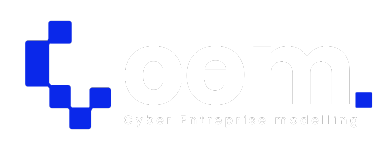
Bring your Security Architecture to Life
The combination of modelling and automation enables you to visualise and validate the behaviour of your architecture at the design stage:
- Improved Communication:
- Models provide a clear, single source of truth, enabling stakeholders from different disciplines to collaborate effectively around a common understanding.
- Automation adds the ability to generate user-friendly, on-demand visualisations;
- Multi-Directional Traceability:
- Models are large, irregular, hyperlinked structures in which each node is connected to the body whole.
No element exists in isolation!. Scripts can navigate and validate these links, enabling full traceability:
e.g. policy to controls, vulnerability to value stream, data lifecycles from creation, to usage and disposal. - This insight helps ensure that stakeholder needs are addressed across the ADM lifecycle.
- Faster Decision-Making:
- As the model provides a machine-readable representation the system, scripts can be used to simulate and analyse system behaviour, performance and trade-offs at design stage. This contributes to the quality and agility of decision-making and problem-solving.
- Reduced Risks:
- By identifying potential issues earlier in the design process, models reduce the risk of costly design flaws or system failures later in development or during operation.
- Improved Consistency and Quality:
- Standardised model notation helps maintain consistency across all stages of design and development, ensuring higher-quality deliverables and seamless integration.
- Automation offers validation against design standards for correctness and completeness
- Agile Change Management:
- Changes can be applied faster and more assuredly as needed. Models enable the impact to be assessed from multiple stakeholder viewpoints, proposed changes can be easily reviewed and, when a decision is made, all documentation can be easily updated.
- This helps teams manage evolving requirements or design modifications effectively.
Aligning Security Strategy to Business Strategy
In today’s digital landscape, security can no longer operate effectively as a standalone function: it must be aligned with business objectives to support growth, resilience, and compliance. Security Strategy must be at the core of an organisation’s Business Strategy and maintained in dynamic alignment for risk management, regulatory compliance, and cyber resilience.
Without this alignment, organisations will likely face delays, inefficiencies, increased costs, and security measures that fail to support business goals, leading to gaps in compliance, increased operational risk, and missed opportunities for innovation.
By ensuring that security objectives directly support business priorities, organisations can achieve agility, cost-effectiveness, and high assurance, while maintaining evidence-based compliance.
Realising Security Strategy as Architecture
Enterprise Architecture (EA) provides a structured and visual approach to designing security solutions that are traceable to business objectives. By using Enterprise Architecture diagrams, organizations can model:
- The derivation of security requirements from business goals.
- The traceability of security controls to risks, policies, and compliance mandates.
- The integration of security processes into the enterprise IT landscape.
The gold standard of these methodologies is SABSA —a risk-driven security framework that maintains a clear line of sight from business strategy to security implementation.
Using Enterprise Architecture modelling, organisations can:
- Define business-driven security attributes using SABSA’s contextual layer.
- Translate business needs into security requirements through logical and conceptual models.
- Automate documentation by generating requirement specifications, risk assessments, and compliance posture from the model.
- Validate security effectiveness with traceable evidence of compliance, risk mitigation and policy enforcement.
Evidence-Based Compliance
At CEM, we have developed a Security Controls Integration Platform that normalizes control requirements from combined standards such as ISO 27000, NIST, and other regulatory frameworks, with continuous expansion to incorporate new regulations.
This has been realised through a model-driven approach to Enterprise Security Architecture , in which an integrated data model—supported by its associated attributes—can be queried for applicable, in-scope security requirements for projects, perform gap analyses, and support compliance efforts.
CEM has also modelled a catalogue of security reference architectures to guide the implementation of the necessary control mechanisms. By assessing a target architecture against the reference architecture, we can quickly identify gaps, create user stories for project requirements, and prioritize gaps based on risk scoring at the program level. The approach is primarily focused on fulfilling compliance and achieving certifications by providing a robust, end-to-end view of control coverage. It also enables rapid adaptation to change, automates analysis and documentation, reduces implementation and design costs, and delivers high-assurance, verifiable security insights from a single, maintainable source.
Integrated Risk Analysis
Architectural models provide an ideal basis for risk analysis. They are a blueprint that shows where assets are located, where threats emanate from, and the exposed attack surfaces and vectors that might be exploited.
- Control Placement:
- From such analysis, the model can then be enriched with the security perspective, showing where controls are deployed: exposing gaps or isolated controls that could be vulnerable as single points of failure.
- Automation can enrich this analysis further, for example by annotating controls with their ‘Detect’, ‘Protect’, ‘Detect’, ‘Respond’ or ‘Recover’ capability to identify the degree of defence in depth..
- Risk Analysis:
- The model’s links enable traceability from technical vulnerabilities to business impacts.
- By capturing the potency of the threat, the effectiveness of controls and the scale & nature of impact, the model contains all the data essential for qualitative or quantitative risk analysis.
- Risk Management:
Cost-effective risk management is complicated by the many-to-many mapping of risks to controls.
Because each risk and each control exists only once in the underlying model, we can use scripts to ensure that control changes are propagated to recalculate all dependent risks in the target architecture.
Security By Design: Enabled by Automation

Security Modelling Capabilities
A model-based system engineering (MBSE) approach to security enables you to visualise, analyse and simulate responses to potential vulnerabilities at the design stage, before they can be exploited.
- Threat scenario modelling
- Compliance alignment (e.g., NIS 2, GDPR, DORA, ISO 27001, NIST, and others)
- Integration with enterprise architecture tools
- Evidence-based dashboarding for management, governance, audits and certifications

Automated Security Frameworks
Streamline security processes with intelligent automation designed for efficiency and precision:
- Continuous security integration during the System Development Lifecycle
- Automated gap detection with traceability to business risk
- Multi-Regulatory & Policy compliance at scale
- Automated compliance evidence generation


